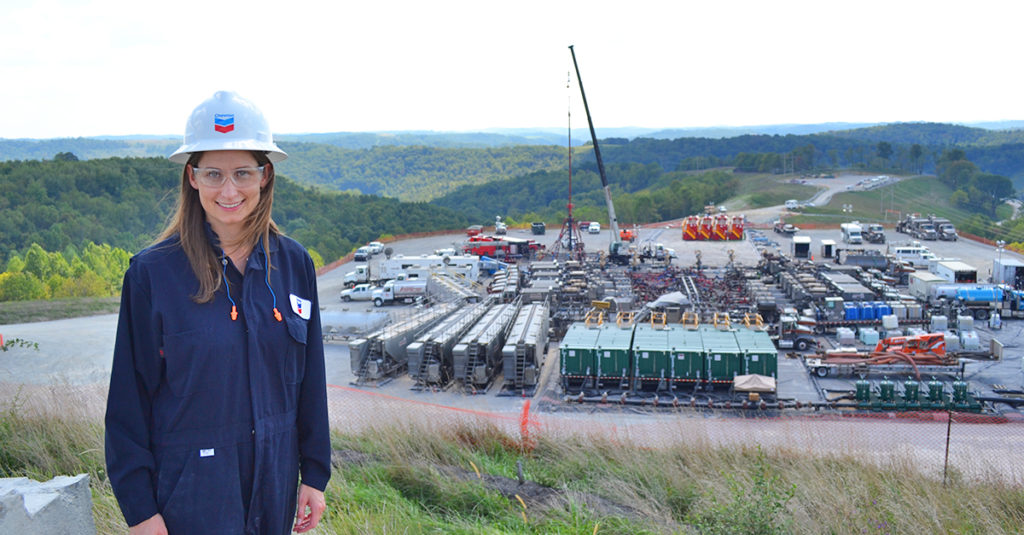Your Questions About Natural Gas, Answered
Natural gas is powering our modern way of life and helping to cut CO2 emissions. Here’s what this energy revolution is all about.
Learn MoreNatural gas is powering our modern way of life and helping to cut CO2 emissions. Here’s what this energy revolution is all about.
Learn MoreChevron’s Vanessa Ryan is on a mission to cut methane emissions

April 10, 2020
People outside the energy sector are often surprised that Vanessa Ryan’s job exists. Ryan is manager of carbon reduction on Chevron’s energy transition team, where she identifies and implements ways the company can reduce methane emissions.

Methane can escape during the production and transportation of natural gas, a critical energy source that is helping lower carbon emissions. Natural gas and oil companies use a variety of tools to help prevent methane emissions, including using advanced optical imaging cameras and drones equipped with infrared sensors to find leaks, so they can quickly be repaired. Their efforts are paying off.
Even as natural gas production increased by more than 70% from 1990 to 2018, EPA’s latest Greenhouse Gas Inventory shows an overall decline of 23% in methane emissions from petroleum and natural gas in the same period.
To build on that progress, a group of 26 leading natural gas and oil companies formed The Environmental Partnership in December 2017. The Partnership, chaired by Ryan, now has 75 members who have committed to further reducing methane emissions through new technology and processes. The member companies work together in this effort, sharing experiences and knowledge. Through her work as one of the Aspen Institute’s First Mover Fellows, Ryan focused her attention on further improving The Environmental Partnership.
We talked with Ryan about her experience with The Environmental Partnership and the future of energy.
Your background is in public policy. What made you want to work in the energy industry?
Energy enables everything we do. And most people don’t think about it on a daily basis because the energy industry quietly and seamlessly solves huge challenges every day. We enable your phone to charge, your airplane to take you where you want to go and your house to stay warm or cool throughout the year. Chevron’s essential role in making human progress possible drew me to the business 12 years ago. I haven’t been bored a day since.

Looking back on your time working at Chevron, what have been some of your most memorable moments?
Launching The Environmental Partnership has been the most rewarding moment of my career. Chevron recognizes that methane emissions are an industry wide concern, and one company alone cannot solve the issue. The openness and willingness of my company and all the other member companies to tackle this issue and work to continuously improve is incredibly energizing.
The Environmental Partnership companies come to the table because they want to learn and improve how they address methane emissions. And they also come ready to share. Every company that joins The Partnership comes at a different place in their journey, from those just learning about the basics, to those that are very sophisticated in their methane reduction strategies. But we all work to solve problems. And solving problems can lead to lower environmental impact and more affordable energy.
Tell us a bit about your experience with the Aspen Institute’s First Mover program?
I was honored to be selected as a First Movers Fellow. I got a chance to work with leading minds and with a network of leaders who had great ideas on how to overcome hurdles from their experiences doing similar work. The Aspen team and my cohort were immensely helpful in focusing on the bigger picture, taking a step back from today’s inbox and helping me see where The Environmental Partnership could go next. Each fellow has a project. Mine was to figure out how The Partnership would scale to meet the needs of the growing list of operators while continuously improving our performance.
You focus on energy transitions. What do you see as the future of energy in America?
We are fortunate in America to have access to safe, reliable and affordable energy. That energy comes from a changing mix of sources. In fact, Chevron’s first primary product was kerosene. Over the last 200 years, we have transitioned from biomass, to coal, now to gas, with strong growth in renewables. Lowering the carbon intensity of oil and natural gas can help the world meet its low carbon goals for the future, alongside the growth of other types of energy, like solar, wind, nuclear and hydroelectric.
What is the single biggest reason for the reduction of carbon dioxide emissions in the United States?
Correct! The U.S. Energy Information Administration reported that from 2005-2019, 65% of the decline in CO2 emissions in the electric power sector was attributable to switching from coal-fired to natural gas-fired electricity generation. Learn more about the power of natural gas.
Good try! The U.S. Energy Information Administration reported that from 2005-2019, 65% of the decline in CO2 emissions in the electric power sector was attributable to the switching from coal-fired to natural gas-fired electricity generation. Learn more.
More From API
Read on for in-depth articles about how we’re securing America’s energy future, our efforts to combat climate change, and more.
New innovations make it possible to produce more energy with fewer emissions Combatting emissions of methane, a potent greenhouse gas, […]
Learn MoreBetween now and 2050, according to the Energy Information Administration, the American demand for electricity will increase 1% each year. To […]
Learn MoreWe’re taking five key steps to reduce greenhouse gas emissions
Learn MoreWe use cookies to offer you a better browsing experience, analyze site traffic, personalize content, and serve targeted advertisements. If you continue to use this site, you consent to the use of cookies. Read more about our Privacy Policy and Terms and Conditions.
accept